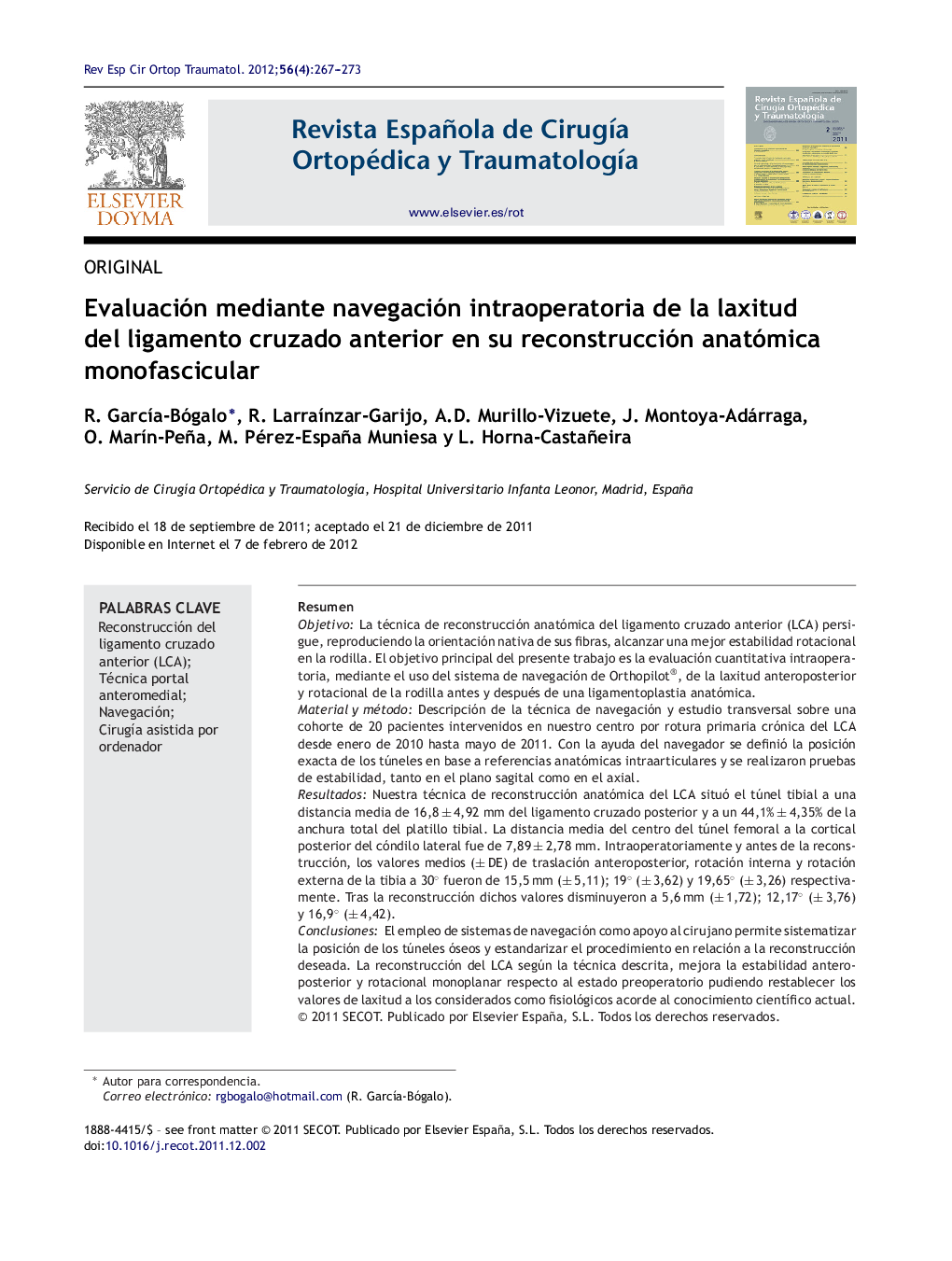| کد مقاله | کد نشریه | سال انتشار | مقاله انگلیسی | نسخه تمام متن |
|---|---|---|---|---|
| 4086516 | 1267958 | 2012 | 7 صفحه PDF | دانلود رایگان |

ResumenObjetivoLa técnica de reconstrucción anatómica del ligamento cruzado anterior (LCA) persigue, reproduciendo la orientación nativa de sus fibras, alcanzar una mejor estabilidad rotacional en la rodilla. El objetivo principal del presente trabajo es la evaluación cuantitativa intraoperatoria, mediante el uso del sistema de navegación de Orthopilot®, de la laxitud anteroposterior y rotacional de la rodilla antes y después de una ligamentoplastia anatómica.Material y métodoDescripción de la técnica de navegación y estudio transversal sobre una cohorte de 20 pacientes intervenidos en nuestro centro por rotura primaria crónica del LCA desde enero de 2010 hasta mayo de 2011. Con la ayuda del navegador se definió la posición exacta de los túneles en base a referencias anatómicas intraarticulares y se realizaron pruebas de estabilidad, tanto en el plano sagital como en el axial.ResultadosNuestra técnica de reconstrucción anatómica del LCA situó el túnel tibial a una distancia media de 16,8 ± 4,92 mm del ligamento cruzado posterior y a un 44,1% ± 4,35% de la anchura total del platillo tibial. La distancia media del centro del túnel femoral a la cortical posterior del cóndilo lateral fue de 7,89 ± 2,78 mm. Intraoperatoriamente y antes de la reconstrucción, los valores medios (± DE) de traslación anteroposterior, rotación interna y rotación externa de la tibia a 30° fueron de 15,5 mm (± 5,11); 19° (± 3,62) y 19,65° (± 3,26) respectivamente. Tras la reconstrucción dichos valores disminuyeron a 5,6 mm (± 1,72); 12,17° (± 3,76) y 16,9° (± 4,42).ConclusionesEl empleo de sistemas de navegación como apoyo al cirujano permite sistematizar la posición de los túneles óseos y estandarizar el procedimiento en relación a la reconstrucción deseada. La reconstrucción del LCA según la técnica descrita, mejora la estabilidad anteroposterior y rotacional monoplanar respecto al estado preoperatorio pudiendo restablecer los valores de laxitud a los considerados como fisiológicos acorde al conocimiento científico actual.
PurposeThe anatomical anterior cruciate ligament (ACL) reconstruction attempts to, by reproducing the natural orientation of its fibres, achieve a better rotational stability of the knee. The aim of this paper is to quantify the anteroposterior and rotational laxity of the knee before and after an anatomic ligamentoplasty using the Orthopilot® navigation system as a supporting tool.Matherial and methodWe describe the distinctive steps of Orthopilot® navigation as well as conducting a retrospective cross-sectional study on a cohort of 20 patients operated in our hospital for chronic primary ACL rupture from january 2010 to may 2011. The precise location of the tunnels was defined with the help of the navigator and the intra-articular landmarks and stability tests were performed in both the sagittal and axial planes.ResultsIn our technique for anatomical ACL reconstruction placed the tibial tunnel at a mean distance of 16.8±4.92 mm from the posterior cruciate ligament in a position that represented 44.1%±4.35 of the total width of the tibial plateau. The average distance from the centre of the femoral tunnel to the posterior cortex of the lateral condyle was 7.89±2.78 mm. Intra-operatively and before ACL reconstruction, the mean (±SD) anteroposterior movement, internal rotation and external rotation of the tibia at 30° position were 15.5 mm (±5.11), 19° (±3.62) and 19.65° (±3.26), respectively. After reconstruction these values decreased to 5.6 mm (±1.72°), 12.17° (±3.76) and 16.9° (±4.42), respectively.ConclusionsThe use of navigation systems supporting the surgery allows the systematic positioning of bone tunnels and standardises the procedures for the desired reconstruction. ACL reconstruction using the technique described, improves the anteroposterior and rotational stability compared to preoperative status, to a stability state that could be considered physiological according to current scientific knowledge.
Journal: Revista Española de Cirugía Ortopédica y Traumatología - Volume 56, Issue 4, July–August 2012, Pages 267–273